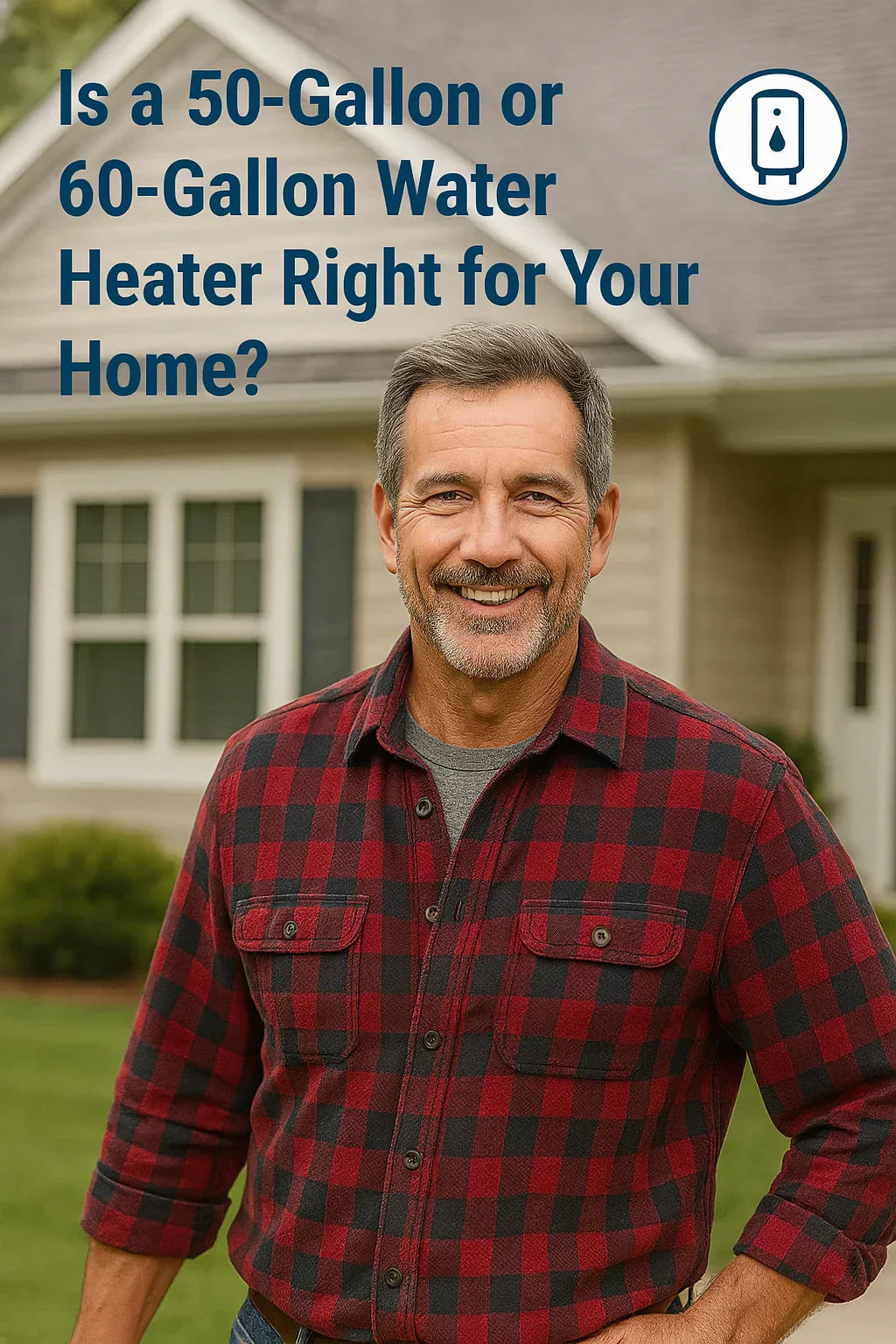When you’re shopping for a new electric water heater, the question often comes down to one key decision: Is a 50-gallon tank enough for your family, or do you need the extra capacity of a 60-gallon unit?
In this comprehensive guide, we’ll walk through the factors that matter most to homeowners like Mike—a value-focused, DIY-savvy homeowner who wants reliability, comfort, and a water heater that just works. We’ll compare 50- and 60-gallon electric water heaters in terms of sizing, performance, energy efficiency, cost, installation, and more.
📊 Understanding Your Hot Water Usage Patterns
Before you even think about tank size, you need to understand how your household uses hot water. Key questions to ask:
-
How many people live in the home?
-
Do you have multiple bathrooms?
-
Are there back-to-back showers in the morning?
-
Do you run the dishwasher and laundry frequently?
Average Hot Water Usage Per Person
-
Shower: 10-15 gallons
-
Dishwasher: 6-10 gallons
-
Laundry: 7-15 gallons
-
Hand washing & miscellaneous: 5-10 gallons
For a family of four, daily usage might range from 60 to 80+ gallons, especially if usage is concentrated in mornings or evenings.
ENERGY STAR’s guide to household water usage provides excellent benchmarks for these estimates.
🧲 What Is First Hour Rating (FHR) and Why It Matters
First Hour Rating (FHR) is one of the most important specs when comparing 50 vs. 60-gallon water heaters. It tells you how much hot water the unit can deliver in the first hour of full demand.
-
50-gallon FHR: Typically 60-80 gallons
-
60-gallon FHR: Typically 70-90+ gallons
Why it matters: If your household showers back-to-back or uses multiple appliances simultaneously, a higher FHR ensures hot water stays available.
⚖️ Comparing 50-Gallon vs. 60-Gallon Models
| Feature | 50-Gallon Tank | 60-Gallon Tank |
|---|---|---|
| Capacity | 50 gallons | 60 gallons |
| First Hour Rating | 60-80 gallons | 70-90+ gallons |
| Ideal Household Size | 3-4 people | 4-5+ people |
| Recovery Rate | 20-25 GPH | 25-30 GPH |
| Height (Tall Models) | 58-62 inches | 62-66 inches |
| Weight | 115-135 lbs | 140-160 lbs |
While the extra 10 gallons might not seem like much, the difference can add 15-20% more available hot water during peak hours.
Check real-world product comparisons like the Rheem Professional Classic Series or AO Smith Signature Premier models to see how these numbers vary by brand.
🏠 Which Size Fits Your Home?
For Mike in a Single-Family Home:
-
Family of 4 with 2 bathrooms? A 50-gallon may suffice if hot water use is staggered.
-
Simultaneous use? A 60-gallon is safer to avoid running out.
For Homes with:
-
Soaker tubs, spa showers, or teens? Lean 60-gallon
-
Small kids with quick showers? 50-gallon could be plenty
If you’re unsure, use a BTU & gallon sizing calculator
⛏ Installation Considerations
Both tank sizes require a dedicated 240V circuit and proper plumbing lines, but here’s what differs:
50-Gallon Pros
-
Easier to fit in most closets or utility rooms
-
Slightly lighter and easier for DIY install
-
Faster to drain and flush for maintenance
60-Gallon Considerations
-
May require additional vertical clearance
-
Heavier—you may need a helper to position
-
Longer recovery times if using lower-wattage elements
💰 Cost: Upfront, Operating & Rebates
| Cost Type | 50-Gallon Heater | 60-Gallon Heater |
| Purchase Price | $500-$900 | $650-$1,200 |
| Installation (Pro) | $600-$850 | $700-$950 |
| Yearly Energy Cost | $350-$550 | $400-$600 |
Rebates & Credits
Many utilities and state programs offer rebates for ENERGY STAR models. Check:
💡 Energy Efficiency: Wattage, Insulation & Recovery
Efficiency depends on more than size. Key specs to compare:
-
Wattage: 4500W elements heat faster than 3500W
-
Insulation (R-value): Higher values mean lower standby loss
-
UEF (Uniform Energy Factor): Aim for UEF > 0.92 on standard models
ENERGY STAR certified electric heaters offer better long-term efficiency and often qualify for rebates.
⚖️ Real-World Scenarios
Scenario 1: Mike’s Suburban Family of 4
-
Daily showers, evening dishwashing, 1-2 loads of laundry
-
Recommendation: 50-gallon if usage is spaced
Scenario 2: Multi-Generational Home (5-6 people)
-
Back-to-back showers, frequent laundry
-
Recommendation: 60-gallon for improved FHR & comfort
Scenario 3: Couple with Frequent Guests
-
Low daily use, but occasional surges
-
Recommendation: Consider 60-gallon to prevent awkward cold-shower moments
🔧 Maintenance Differences
Both tank sizes require similar upkeep:
-
Drain sediment 1-2 times per year
-
Test pressure relief valve
-
Inspect anode rod every 2-3 years
60-gallon tanks may take longer to drain and flush, but also offer more buffer against hard water buildup.
See Home Depot’s DIY water heater maintenance guide for step-by-step instructions.
🔍 Bottom Line: Which Tank Should You Choose?
Choose a 50-gallon electric water heater if:
-
You have 3-4 people in the home
-
Usage is moderately spaced
-
Budget and space are limiting factors
Choose a 60-gallon electric water heater if:
-
You regularly run out of hot water
-
You have high peak-hour demand
-
You want future-proof capacity
✅ Final Takeaway for Mike
For most average families of 3-4, a 50-gallon heater will work fine—as long as usage is reasonably spaced out. But if you’re noticing cold showers, have teenagers, or plan to grow the household, the 60-gallon model gives you a buffer that often pays off in comfort.
When in doubt, go bigger—but only if your space and budget allow it.
Need help picking a model that fits your space and electric panel? Use the Furnace Outlet Sizing Tool to find the right unit in minutes.
In the next topic we will know more about: What to Know Before Upgrading to a 60-Gallon Electric Water Heater







